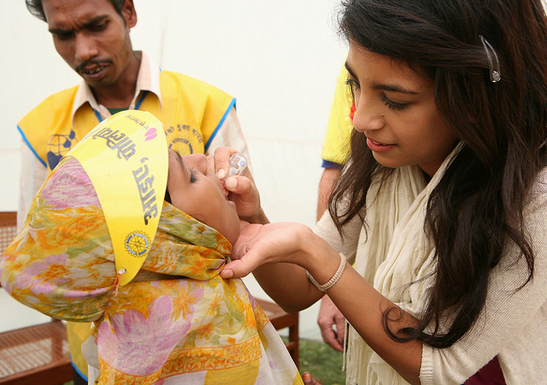The UN-backed effort to wipe polio off the face of the earth reached has reached a major milestone.
Exactly three years ago today — January 13, 2011 — a young girl in West Bengal State, India was diagnosed with Polio. She was the last person in India to ever have contracted the virus.
There have been no new infections in the last three years in India, meaning that the World Health Organization can officially certify that a virus that was endemic for centuries in India has now become eradicated from it. This will likely happen next month.
This is a huge public health accomplishment. Before the Global Polio Eradication Initiative was launched in 1988, India was the country with by far the highest disease burden. Some 200,000 Indian children contracted Polio each year. By 2010, there were only 42 cases. By 2011, just that one case. And for the past three years, zero new cases.
How did this happen? International philanthropies like Rotary International and the Gates Foundation, the United Nations and local government partners came together in an unprecedented way to provide the funding and political will required to vaccinate hundreds of millions of Indian children. Over 2 million people were hired as Polio workers, to promote buy-in from local populations and to make sure that even the most hard-to-reach communities were brought the vaccine. It was a massive undertaking, logistically, politically and financially — and it worked.
There are still three countries where polio is endemic: Pakistan, Afghanistan, and Nigeria. Imported cases of Polio were also reported in Syria last year — the first time in 14 years — amid a total breakdown of that country’s public health infrastructure and the WHO is in the midst of a massive vaccination campaign in the Middle East to try and contain the virus.
To be sure, the outbreak in Syria and ongoing local cases in Pakistan, Afghanistan, and Nigeria are a setback in the effort to rid the world of this scourge, but it is worth putting the fight against Polio in a larger historical context. For hundreds of years, this virus debilitated millions of children around the world. The vaccine was discovered in 1955, and by the mid-to-late 1970s most western countries were rid of the disease.
But Polio doesn’t respect borders, so the international community began dreaming up strategies to bring the vaccine to the developing world and in the mid-1980s the international community boldly committed to wiping this historic scourge from the face of the earth. It was an audacious objective, but one that is now eminently reachable.
The lesson here is that we should not be afraid to dream big in public health. If we can end Polio, we can eradicate measles or even AIDS. Thanks to the Global Polio Eradication Initiative we know that such goals are not only worthwhile–but absolutely achievable.
